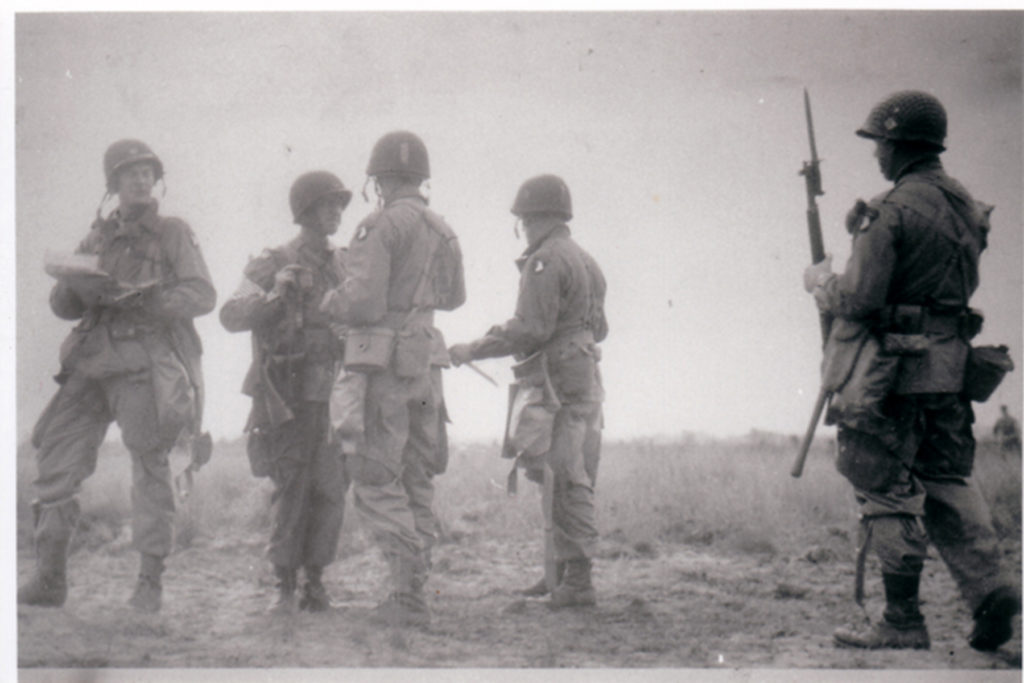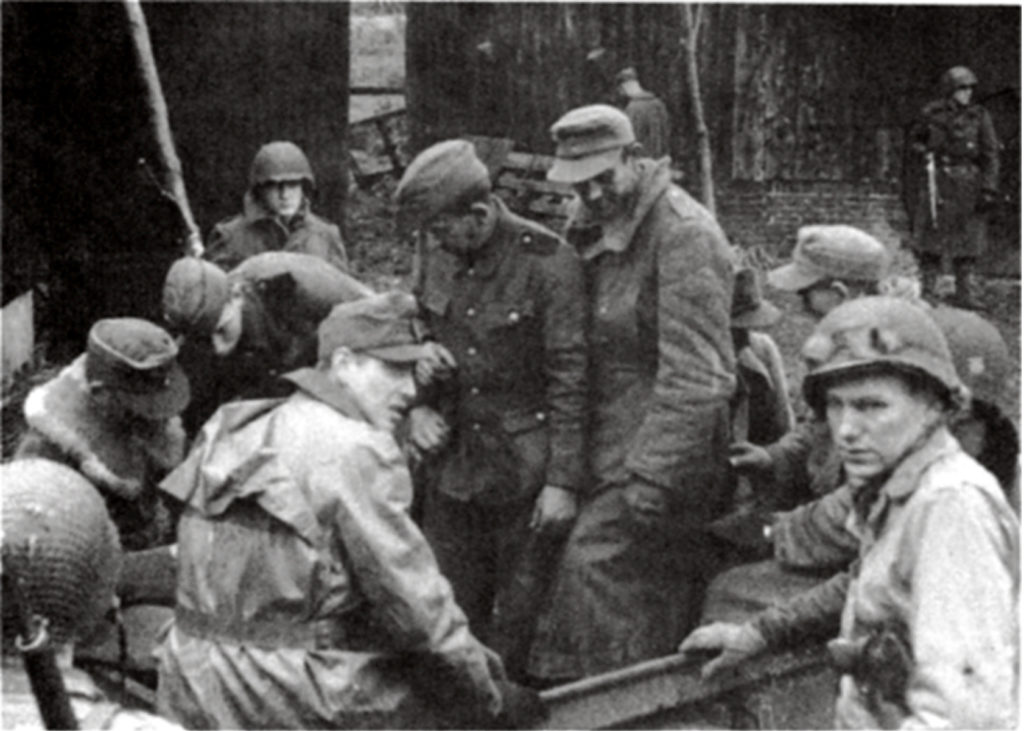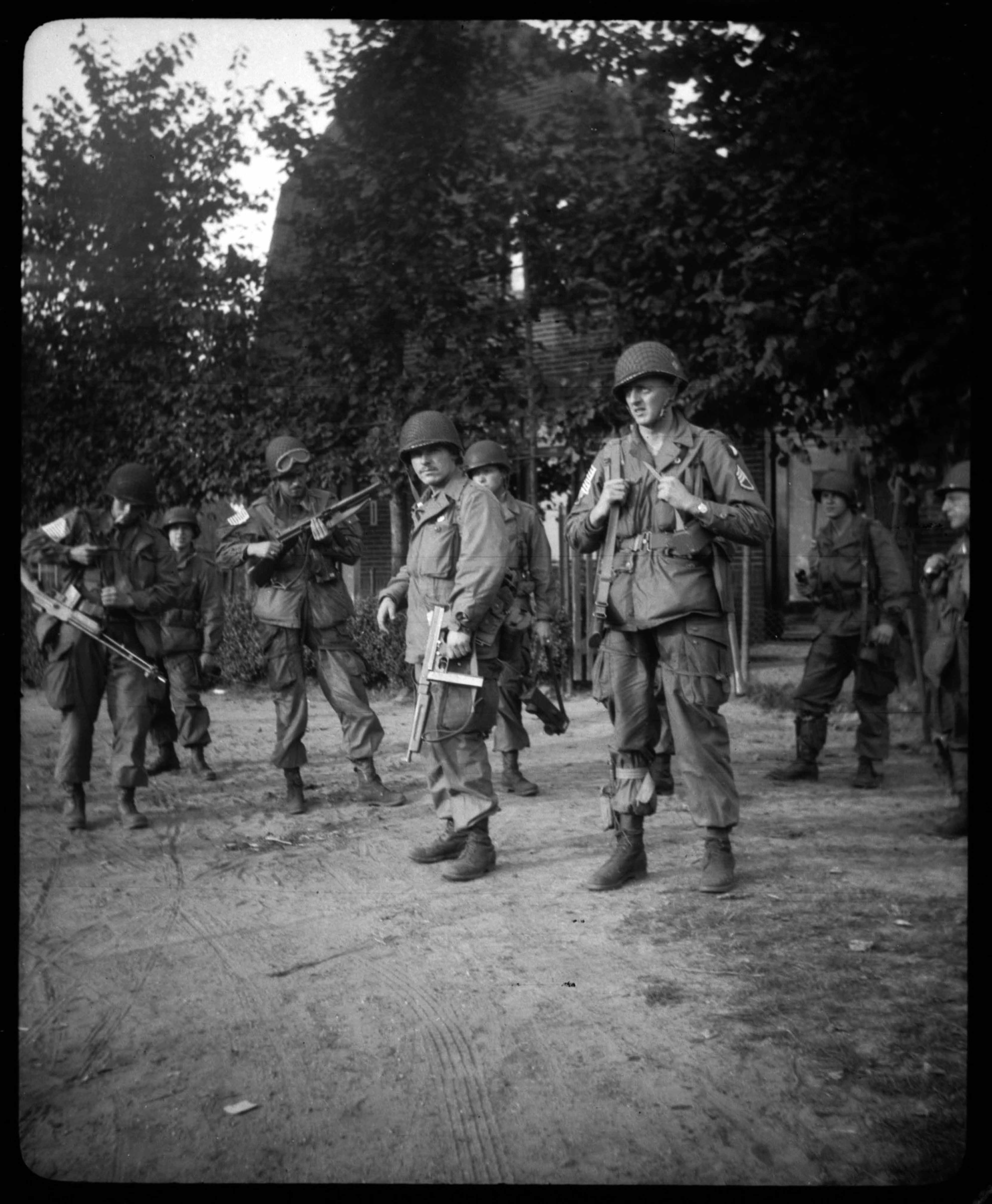It was 1944, and members of the 501st Parachute Infantry Regiment, 101st Airborne Division, were bold enough to take on a seemingly impossible mission.
[dropcap]I[/dropcap]t was after 8 p.m. on October 30, 1944, when the six men heard shovels clunk against the ground. To Private First Class Bob Nicholai, a seasoned scout, they were “the unmistakable sound of Germans digging in for the night.” Edging forward through the rain-spattered darkness on the north bank of Holland’s Nederrijn River, another American soldier stumbled into some brush. “Immediately we stood still as statues,” Nicholai recalled. “Then we heard the zip of a German flare going up. We hit the ground and froze.” More flares lit up the countryside. The men could hear Germans moving to either side of them. Only Pete Frank, a master sergeant fluent in German, understood the enemy shouts: “Why the flares?” one jittery German asked. “Somebody heard something,” replied another.
Each time a German flare burned out, the Americans—members of the 501st Parachute Infantry Regiment, 101st Airborne Division—crept forward between the flanking Germans. They were just minutes into what was planned as a day-and-a-half mission. A half hour later, with miles to go before daybreak, they had covered fewer than 900 feet. What would later be hailed as the “Incredible Patrol” was off to an inauspicious start.
THE 501st HAD BEEN BUILT and led by Lieutenant Colonel Howard R. “Skeets” Johnson, 39, a former collegiate boxer whom 101st Division commander Major General Maxwell D. Taylor described as “tough, very tough.” Noting Johnson’s 100-plus parachute jumps, Taylor said: “He wanted his 501 to win the war all by itself and worked his troops awfully hard.”
The night before Johnson’s unit made their first parachute jump, they watched the 1939 film Geronimo. In the words of the movie’s poster, it told the story of the “most feared Apache that ever ravaged the West…leading his 10,000 yelling demons into roaring battle.” From then on, the 501st became the “Geronimos.” They were mobile airborne shock troops who were to overrun and hold key objectives until traditional infantry, armor, and artillery could arrive. Though meant to withdraw as soon as possible and prepare for the next fight, fine, aggressive units like these were prized—and often commandeered—by higher-level leaders.
The Geronimos’ first combat jump was into France before dawn on D-Day, June 6, 1944. Despite major setbacks, Johnson’s men gained a toehold across the Douve River north of the city of Carentan. Though meeting their objectives within the first week, the 501st continued fighting through mid-July. Casualties, already high, climbed higher.
Worse occurred during Operation Market, the September 17, 1944, combat jump into Holland, which was synchronized with a British ground thrust called Operation Garden. Skeets’s men again met their objectives, but when the combined operation, called Market Garden, faltered they stayed on to bolster British defenses. American commanders repositioned three 101st Division regiments (the 501st included) in static positions just south of the Nederrijn, a Rhine River tributary that arced north of the main river and swept by the city of Arnhem. “Ordinary infantry,” griped a cynic among the Geronimos. “That’s all we are.”
On October 8, while Skeets Johnson was inspecting front lines near the banks of the Nederrijn, a German artillery round mortally wounded him. In Johnson’s final moments he implored his soon-to-be successor, Lieutenant Colonel Julian J. Ewell, to “take care of my boys.” The 501st had lost its hard-driving founder. Colonel Ewell was capable and respected—but some veteran members of the unit feared the Geronimos stood to lose their fighting edge under Ewell’s command.

ONE SUCH SKEPTIC was First Lieutenant Hugo S. Sims Jr., the regiment’s controversial and confident intelligence officer. First Lieutenant Laurence Critchell, a colleague who later wrote a book about the regiment’s exploits, described Sims as having “a rather superior air that annoyed other officers.” While no one denied that Sims—a short, wiry 23-year-old native of Orangeburg, South Carolina—was competent, “everyone doubted whether he was as good as he thought he was.”
Differing opinions on Sims’s abilities were nothing new. When he first tried for a commission while still in college, every military branch rejected him. After graduation, not yet 20 but already married and father of an infant son, Sims enlisted in the army. Fully expecting to vault from basic to officer training, he was disappointed again. “A real shock to my ego,” he reflected much later.
Persistence eventually paid off. Three months after enlisting, Sims began officer training at Fort Benning, home of the U.S. Army’s nascent paratrooper program. After graduation, Second Lieutenant Sims was tapped to join the Geronimos. He earned a Bronze Star leading a platoon in Normandy.
As regiment intelligence officer (called an S-2), Sims was supposed to know what the Germans were up to on the north side of the Nederrijn. If they were building up for a surprise attack, the result could be devastating and the blame would be his. Taylor’s chief of staff, Brigadier General Gerald J. Higgins, impressed upon Sims the need to get German POWs for interrogation.
Cross-river patrols were a battalion responsibility. But, with winter approaching and fighting tamped down, soldiers ordered out on patrol wondered why they should risk their lives. As Sims described it: “There was a strong feeling that this patrolling was unnecessary…. One of the patrols even punctured the rubber boats to be used [to cross the river] so the patrol would have to be called off.”
To gather the intelligence needed—and to shame the battalions into doing better—Sims imagined leading a textbook patrol: cross the river; sneak on foot well behind enemy lines after dark; hide in an observation post during the day; report enemy traffic by radio; and return with a few POWs under cover of darkness. Getting Colonel Ewell’s okay, Sims hatched his plan during the waning days of October. Scanning aerial photographs, he selected his observation post: a house along the main highway about six miles northwest of Arnhem. To keep their bearings en route, Sims arranged for British artillery to periodically fire a shell at known coordinates in the area. To light the way, he scheduled his own regimental mortars to fire a single flare every half hour.
Sims chose five volunteers—four from his S-2 team and one from a POW interrogation group. Corporal William R. Canfield of Selman, Oklahoma, Sims’s assistant, was, as Sims put it, “big, quiet, and dependable.” Three more were expert scouts: Private First Class Robert O. Nicholai, a self-assured former merchant mariner from Midlothian, Illinois; Private Roland J. Wilbur, an M-1 sharpshooter from Lansing, Michigan; and Private First Class Frederick J. Becker of Atlantic, Iowa. Knowing he’d need a German speaker, Sims approached Master Sergeant Peter Frank, an Austrian-born New Yorker and POW interrogator. Frank knew nothing about scouting but welcomed the chance to go.
As word leaked out about the mission, set for October 30, other regiment officers kibitzed and wisecracked. “Poor Huey—age 1,” said one, alluding to Sims’s young son. Meanwhile, as Lieutenant Critchell later wrote, battalion officers whose earlier patrols had failed “settled down to watch the fun.”
NORTH OF THE NEDERRIJN, after eluding the flurry of German flares, Sims’s patrol navigated around a pond, crossed a road, and found themselves close to a lighted tent. Bob Nicholai thought the tent might contain a German officer: “a good bag.” But despite the near-disastrous brush with German flares in the patrol’s first minutes, Sims judged it too early to take prisoners and return. As they moved stealthily northeast, he also rejected subsequent opportunities, including a “big fat Jerry [German] snoring away” in a slit trench.
Forbearance soon paid off when the six men stumbled across an ammunition dump. Pete Frank crawled forward to decipher the markings on ammo boxes: shells for 150mm guns. As Sims jotted down the dump’s locale and contents, someone heard the distinctive sound of German submachine guns being cocked. They stood still. When no challenge came, the patrol pressed on.
After crossing fields and wooded areas, the men reached a well-paved road and made two more discoveries: a huge—but unmanned—gun emplacement and, about 300 feet farther on, a motor pool filled with parked vehicles. Pulling out a map, Sims marked the locations and vetoed—for now—his men’s pleas to steal a vehicle. They were now near the Dutch town of Wolfheze, about six miles west of Arnhem. Wisely, Sims decided to skirt the town. As they sneaked past Wolfheze’s western fringes, the air, Frank reported later, was thick with “the smoke from stinking German cigarettes.”
By the time Sims and his men passed a set of railroad tracks—two-thirds of the way to the intended observation post—they were feeling cocky. Nicholai, having pulled a handful of carrots from a vegetable patch, munched nonchalantly. Pete Frank spoke to Fred Becker in German, though the Iowan understood not a single word. When one man began singing “Lili Marlene,” the well-known German love song, everyone joined in.
Sims’s deft navigation brought them to the targeted observation post well before dawn. But finding the building and its surroundings deserted gave him second thoughts. Any activity at a site the Germans knew to be empty might raise suspicions. Instead, a mile up the road, they found two less-desolate houses, one with Red Cross markings. Frank and Nicholai, scouting inside this house, spied two Germans sleeping on a bed of straw. That cinched it for Sims: they’d capture the two Germans, set up the post there, and radio back what they’d discovered.
AT FIRST, the two drowsy Germans—cavalrymen sporting shiny black boots—simply could not believe they’d been taken prisoner. As Nicholai wielded his Thompson submachine gun, Frank interrogated them. Meanwhile, Canfield and Wilbur watched the highway while Sims and Becker climbed to the attic, set up the radio, and began transmitting: “This is Sims, Sims, Sims. We have two prisoners.” Soon thereafter, things went quiet. The two Germans told Frank they were expecting someone to pick them up that morning. The patrol waited in the lingering darkness, taking turns watching for traffic or guarding the POWs while others dozed.
At 7 a.m., guests began dropping in, though not the ones anticipated. First to arrive were two teenage Dutch brothers. The house, they explained, belonged to friends who had been evacuated and they had come to look for preserves. The elder brother, a member of the Dutch underground, supplied information about German units and positions that Sims radioed back to headquarters. Within the hour, a half-dozen more civilians showed up, each intending to retrieve some item. While all were pleased to see the Americans, none liked the idea that, for security purposes, they would have to stay there until their hosts departed. As hours passed and hunger set in, however, everyone settled into a communal repast of bread, cheese, and K-ration chocolate. Throughout the day, as convoys of German trucks and artillery rumbled east toward Arnhem, Sims continued radio transmissions. To all appearances, the Germans weren’t pulling out.
Meanwhile, the team captured more drop-ins. First, an unsuspecting German mail courier who wandered into the courtyard for a drink of water. Then, in late morning, the belated arrival by horse cart of the German scheduled to pick up the first two POWs. Finally, as the afternoon lengthened and departure time approached, a pair of enlisted Germans, intending to shirk duty in what they thought was an empty house. Sims now realized his team would need transport. How else to return with six POWs? Sims also anticipated new risks at the Nederrijn. As a group of six, it was one thing to sneak through enemy lines. But as a dozen?
LEAVING BECKER to guard five POWs, the rest of the patrol took cover near the highway, positioning the German mail courier—the most accommodating of the POWs—to shout “Halt Kamerad!” when the right vehicle approached. Back in the house, the remaining POWs—all Russian Front veterans—grew jittery. “Would they be shot?” one trembling POW pantomimed. “No,” Becker gestured in response, though he, too, doubted the likelihood of bringing so many captives back alive.
The first vehicles to appear were pedal-driven. “Guten Abend,” the courier shouted amiably as a company of German bicycle troops streamed by. Next, when a lone German motorcyclist slowed to enter the courtyard, Nicholai dashed from hiding to grab him. The mail courier immediately recognized this new POW, a comrade he had served with before. Finally, the two POW buddies, acting as decoys, flagged down a five-ton cargo truck. The patrol at last had their vehicle, but new complications as well: 14 dozing SS troops sprawled inside the tarpaulin-covered cargo bay.
With darkness now upon them and much to do before dawn, Sims ordered the sleepy SS men disarmed and the other POWs retrieved from the house. Sims and Frank jumped into the cab beside the driver. In the back, meanwhile, Canfield, Nicholai, Wilbur, and Becker spaced themselves among the 21 POWs and the truck rumbled off on a return route Sims had mapped out. Shortly after they got underway, the SS battalion commander’s jeep pulled alongside. Vaulting from the back of the truck, Canfield captured the officer—a captain—and his driver.
As they drove toward Arnhem, Sims told the truck’s driver to pull off the highway and continue cross-country. They hadn’t gone far when the truck mired hubcap-deep in mud; everyone climbed out to proceed on foot. Sensing his chance, the SS captain ran off with Nicholai at his heels. Two shots rang out from Nicholai’s Thompson—the only rounds yet fired by the patrol. Moments later, Nicholai returned with the SS captain in tow. Lining up the POWs in two columns, Frank explained stark realities: The patrol could as easily shoot the Germans as take them back alive. Anyone trying to escape or make unnecessary noise would be shot immediately.
After once more skirting Wolfheze, the patrol reached the outskirts of Renkum, about a mile to the southwest. Since daylight was scant hours away, Sims decided to risk marching straight through the center of town. As he recalled: “The Germans had those hobnailed boots that made a lot of noise. People would probably think it was just a group of Germans [headed for] the front lines. You know, if you are bold you do much better.”
Once safely through Renkum, moving like alert, well-armed shepherds, the patrol herded the 24 captives down a street leading directly to the Nederrijn. “We could see German soldiers down there in foxholes at the edge of the river,” Sims recalled, but he and his men were not about to be denied. “I ran to one [foxhole] and, without [me] giving any orders, two of my men ran to the two other foxholes.” With eight more captives in the flock, the six-man patrol was now shepherding 32 POWs.

AIDED BY GERONIMOS poised on the south bank, the re-crossing of the Nederrijn proved a routine—though lengthy—process as they ferried the POWs in small groups. Conceded the SS captain to Sims once transport was complete: “I congratulate you; I didn’t think it was possible.”
Afterward, as interrogations of the 32 POWs and patrol debriefings proceeded, plaudits enveloped Sims’s team. Sims dined personally with General Taylor, and received both a Distinguished Service Cross and a meritorious promotion to captain; Frank received a field commission; and Becker and Wilbur (and likely the other three enlisted Geronimos as well) received Silver Stars.
Intelligence gleaned by the patrol and subsequent POW interrogations revealed that while the Germans were not pulling back, a winter stalemate lay ahead along the Nederrijn. Accordingly, on November 24, after two-and-a-half months on the front lines, the 101st Airborne regiments finally decamped and pulled south to Reims, France, for rest and refit.
By the time the American public read “The Incredible Patrol,” in the January 15, 1945, issue of Life magazine, the Geronimos’ reputation had soared to still greater heights. Ironically, given Hugo Sims’s preoccupation with gathering timely intelligence, it took a monumental gaffe by army intelligence personnel stationed in Belgium’s Ardennes Forest—the failure to detect the build-up of German armor and troops—to force the 101st back to the front lines.
In mid-December 1944, as German armor and infantry kicked off what ballooned into the Battle of the Bulge, the reinvigorated Geronimos spearheaded the spirited defense of a Belgian crossroads town. On December 19, moving to make a stand east of beleaguered Bastogne, the 501st encountered GIs in headlong retreat. Sims realized they were panic-stricken, “but we told them: ‘You can stop running now, the 101st is here.’”✯





